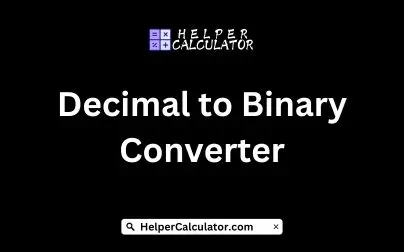A Decimal to Binary Converter is a tool or algorithm that converts a decimal number (a number in the base-10 system) into its equivalent binary representation (base-2 system). This conversion is crucial in many fields, especially in computing and digital electronics, where binary is the fundamental language used to represent data.
Key Concepts and Process:
1. Decimal Number System (Base-10): In this system, numbers are represented using ten digits (0 to 9), with each digit's position representing a power of 10.
- Example: The decimal number 45 is equal to 4 x 10^1 + 5 x 10^0.
2. Binary Number System (Base-2): This system uses only two digits: 0 and 1. Each digit in a binary number represents a power of 2.
- Example: The binary number 1011 is equal to 1 x 2^3 + 0 x 2^2 + 1 x 2^1 + 1 x 2^0 = 11 in decimal.
3. Conversion Process:
- To convert a decimal number to binary, the tool repeatedly divides the decimal number by 2, noting the remainders at each step.
- The binary representation is then formed by reading the remainders from bottom to top.
- Example: Converting decimal 13 to binary:
1. 13 ÷ 2 = 6 remainder 1
2. 6 ÷ 2 = 3 remainder 0
3. 3 ÷ 2 = 1 remainder 1
4. 1 ÷ 2 = 0 remainder 1
Result: Reading the remainders in reverse order: 1101 (binary representation of 13).
4. Handling Fractional Decimals: If the decimal number has a fractional part, the converter can use multiplication by 2 for the fractional part and keep track of the integer portions to form the binary fraction.
- Example: For 0.625, multiply 0.625 by 2:
1. 0.625 × 2 = 1.25 (integer part 1)
2. 0.25 × 2 = 0.5 (integer part 0)
3. 0.5 × 2 = 1.0 (integer part 1)
Result: 0.625 in decimal = 0.101 in binary.
Benefits:
- Efficiency: Converts decimal numbers into binary, which is essential for computer systems, programming, and digital systems.
- Understanding: Helps users understand how decimal numbers are represented in a binary system, which is foundational for computing and digital technologies.
- Versatility: Useful for applications in computer science, electrical engineering, digital logic design, and programming.
Applications:
- Programming: Converting decimal numbers to binary is fundamental in programming, especially when dealing with binary data, bitwise operations, and memory addresses.
- Digital Electronics: In hardware and electronics, binary is used to represent data in processors, memory, and other digital devices.
- Computer Science: Binary representation is crucial for data storage, compression algorithms, and network communication.
In short, a Decimal to Binary Converter simplifies the process of converting decimal numbers into binary, aiding in computational tasks and providing a clearer understanding of binary-based systems.
Decimal to Binary Converter
Tags:
Unit Conversion Tools
